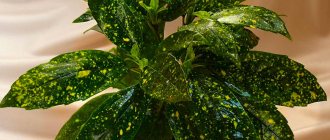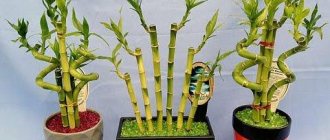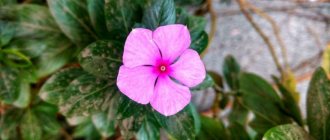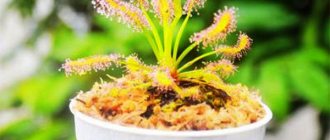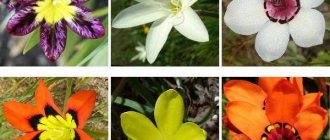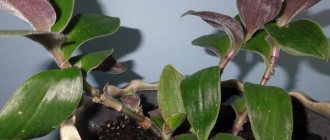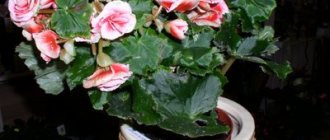Aucuba, or “golden tree,” is an exotic plant that has been attracting tourists from East Asia for many years. When the opportunity arose to export the female plant from Japan after it bore fruit, people realized that Aucuba was a dicotyledonous plant. In order for the plant to begin to spread throughout the world, a male bush was required.
It is a hardy subtropical plant that can survive even in the deep shade of a forest. There are eight species found in China, Japan, Korea and the Himalayas. An evergreen shrub with red flowers has been adapted for growing indoors. The most popular species is the Japanese aucuba.
Aucuba, with yellow spots on its leathery leaves, is a typically green shrub reaching 3-4 meters in height. During flowering, the plant displays small, inconspicuous flowers with panicles that are usually reddish or purple. The growth is lush, increasing annually by 15-20 cm in length. A potted perennial can have a lifespan of 10 years or more.
| In one season the plant reaches a height of 15-20 cm. |
| It blooms in summer and can also bloom in winter if it is very humid. |
| Blooms in spring with small red flowers. |
| Perennial. |
Beneficial features
Benefits include:
- Purifying the air from harmful bacteria;
- Treatment of burns, frostbite, bumps, bruises, bruises on the body;
- Wound care.
Absorbs the negative energy of people and is considered a tree that promotes family well-being. This flower is considered a home talisman in China, Korea and Japan, and more recently in many other countries.
Difference from Croton
Reference. Aucuba is very similar to another plant species - croton. Without serious knowledge of botany, some of their species can be confused - this often happens.
But even an amateur can understand the difference by the following signs:
- dying leaves of aucuba turn black, and those of croton turn yellow;
- Aucuba has opposite leaves, Croton has alternate leaves;
- During the flowering period, these plants are easy to distinguish - unlike aucuba, croton blooms with tassels similar to mimosa.
Features of growing at home. Briefly
Aucuba is undemanding in domestic conditions. However, this plant still requires some care:
| Temperature | The plant feels comfortable in cool conditions, the optimal temperature is 20°C, no more, and in winter from 5 to 10°C. |
| Humidity | Average. It does not suffer from dry air, but spraying will not be superfluous, especially in winter when the heating system is running. |
| Lighting | The plant needs diffused light. |
| Irrigation | Moderation in the soil is very important. Once a week in summer and once every two weeks in winter. Let the soil dry out between waterings. |
| The soil | Plants grow best in light soil. |
| Application of fertilizers and fertilizers | You can purchase organic, mineral, and granular fertilizers. Apply once every 3-4 months from spring to late summer. |
| Transfer | If the plants are young, apply the treatment once every 1-2 years in the spring. For adults, reduce the frequency to once every 2-3 years. |
| Spreading | There are 2 main methods - propagation by cuttings and propagation by seeds, but growth occurs much more slowly. |
| Special cultivation characteristics | To make it comfortable for the plant to grow and bloom indoors, in the summer you can take the pot with aucuba outside. He is able to live even in smoky air. You should also prune regularly. |
Aucuba japonica: useful, but poisonous
There is nothing outstanding in the flowering But the fruits - red juicy berries - look very beautiful on the bush.
As scientists have found, aucuba juice contains active substances: aucubin, aucubigenin and shikimic acid, thanks to which the plant releases volatile substances into the air that have antiviral, antifungal and antibacterial activity.
So the original shrub, originally from the land of the rising sun, can not only decorate your home, but also provide first aid for injuries, cuts, and insect bites.
Crushed leaves and fruits are used for treatment Carefully! To use Japanese aucuba as a remedy, you need to know the exact dosages and first consult with your doctor. The tissues of the plant contain toxic substances.
Caring for aucuba at home. Details
Landing
For planting, a mixture of soil, peat and sand is used. When replanting mature plants, select and carefully follow the replanting method into another container.
Seedlings should be planted in a mixture of peat and sand or clean sand in late winter or early spring. The temperature should be maintained at 20-22 °C.
Bloom
The aesthetic appearance of aucuba is created by its large, bright green leaves. If the aucuba grows indoors, it may bloom periodically. During this period, the apical inflorescences are usually painted in red, fiery, reddish colors. The shades pair well with rich green-yellow foliage.
If both male and female specimens are present, oblong red fruits appear after flowering, somewhat reminiscent of barberry. The flowering period ends in late winter or early spring. Some people use red fruits in cooking and folk medicine.
Temperature
House aucuba will grow well at temperatures of 18-20°C in autumn and spring and 10-14°C in winter. Increasing temperatures encourage leaf shedding. In summer, the potted plant can be placed outside, but it should be protected from direct sunlight and possible precipitation.
Spraying
The aucuba flower at home requires mandatory spraying in the cold season, when the air in the house is dried by radiators and other appliances, and the central heating is turned on. If the room temperature is low, spraying should be carried out moderately and carefully, in limited quantities, otherwise it will lead to the appearance and spread of mold.
At other times of the year, you can forget about spraying the Aucuba indoor plant; this is not necessary.
Lighting
It is strictly contraindicated to place the pot near a south window. It grows even in poor light, but without light this process slows down. Varieties with dark green leaves can exist comfortably even in constant shade.
Watering
Water deeply in May and summer months. The plant should be watered when the surface of the soil begins to dry out.
During the cooler months and fall, the plant will not need additional watering. Excessive soil moisture causes the leaves to darken and worsens their appearance.
Pot
Aucuba requires special and careful care, then it can live its whole life in one pot. Therefore, it can be immediately planted in a large pot.
If you choose a medium or small pot, then over time a significant number of plant roots will interfere with its comfortable existence.
Therefore, a transplant in this case is inevitable. If you initially chose a very spacious pot, make sure it has good drainage.
Priming
To create soil, take equal proportions of turf soil, coarse sand, perlite, wet peat or humus. The pot should also have holes and drainage.
Feeding and fertilizer
Fertilize your indoor flower with watering from early spring until August. Mineral fertilizer is required in standard concentration. Follow the mixing ratio indicated by the manufacturer on the packaging. Fertilization is not required in autumn and winter, since the plant is dormant at this time of year.
With insufficient fertilizer and nutrition, small leaves appear on the stems and branches.
Transfer
Repot your aucuba plants indoors every year until they are 5 years old. Repot the plant as needed when the roots no longer fit in the pot. When the plant reaches five years of age, replanting will no longer be required.
To do this correctly, place a layer of drainage on the bottom of the pot. This will prevent excess moisture from damaging the plant. Then prepare a substrate from equal proportions of peat, leaf soil and sand. You can also prepare the soil from turf and leaf soil, mulch, sand and peat. When replanting, it is necessary to handle the Aucuba root system very carefully. They are usually very voluminous and lush.
Trimming
Pruning and pruning of young shoots should be done in March. This will give the plant a lush, straight crown. Young shoots after cutting can be used for propagation.
Rest period
The dormant period for aucuba plants begins in mid-autumn and lasts until mid-winter. From October to February, plants go dormant and many physiological processes slow down or stop completely. The flower does not produce new leaves or inflorescences.
During the hibernation period, the plant needs a temperature of 8-14°C, regular and moderate watering.
Description of indoor spotted plant
Aucuba are evergreen shrubs, of which two types are cultivated at home: Himalayan and Japanese - both are divided into several varieties.
The plant does not bloom in its classical sense : the flowers are small and barely noticeable, intended only for reproduction, and have no decorative value. It is distinguished by lush foliage of different types (depending on the type and variety), therefore it is used for designer landscaping of premises and garden areas.
Indoors it is usually a fairly large floor bush. In street areas it is often pruned to give it a special shape or to prevent excessive growth.
Reproduction
In plant breeding, two propagation methods are used: cuttings and seeds.
Propagation by cuttings
Propagation is propagation that uses apical shoots from the previous year. To root, shoots must have at least three leaves.
- The cuttings are placed in a mixture of peat or clean sand under plastic or glass.
- The soil should be moistened and aerated weekly, and the temperature should be maintained at 22 °C.
- Only when the cuttings are completely rooted can they be transplanted into other pots.
Growing Aucuba from Seeds
Propagation from seeds involves harvesting a fresh harvest.
- Male and female individuals growing in close proximity to each other are artificially crossed.
- The collected seeds should be sown in the ground, also covered with glass or polyethylene and placed in a warm place in the room.
- Periodically water the soil and ventilate the container.
- It will take some time before the sprouts sprout. They can be replanted into separate pots only when the young plants grow to 3-4 leaves. However, this method may lead to loss of varietal characteristics.
Temperature and watering
It is advisable for the golden tree to overwinter at temperatures from 8°C to 10-12°C. If these indicators increase by just a few degrees, the plant may shed its leaves.
Watering in winter should be reduced to a minimum. Aucuba is not too moisture-loving; it will more easily tolerate the relative dryness of an earthen clod than waterlogging (because of this, black spots may appear on the foliage).
Read about caring for Tradescantia in your home garden.
If your home is favored by myrtle, take note of these simple rules for caring for it.
Know more about begonia https://sad-doma.net/houseplants/dekarativnotsvetushhie/begoniya/rodina-begonii.html and the homeland of this amazing plant.
Diseases and pests
The houseplant aucuba can be affected by the following diseases:
- Aucuba leaves turn yellow and their tips wither - excess light.
- The leaves are small - this means unsaturated soil, devoid of nutrients and minerals.
- The lower leaves turn yellow early and begin to fall off - large temperature changes, irregular watering.
- Fewer yellow spots on leaves means lack of nutrients or light.
- Black spots on the leaves indicate excess moisture in the soil.
- Drying crowns - staying in a room with dry air.
- Thin shoots and slow growth are a lack of nutrition.
Indoor aucuba can be attacked by pests such as whiteflies, lepidopterans, mealybugs, and spider mites.
Possible problems
With improper care or inappropriate growing conditions, the following problems may occur with indoor aucuba:
- Aucuba leaves turn pale . This occurs when the lighting is too intense.
- The foliage is losing its pattern . The plant does not have enough light.
- Shrinking of foliage . The bush feels a lack of nutrients; to correct this, apply fertilizer to the substrate systematically.
- Flying leaves . The reason for this may be too dry air or excessively high air temperature.
- Yellowing and flying of the lower leaf blades . This may be due to improper watering or a sudden change in temperature.
- The edges and tops of the leaf blades dry out . This can happen due to excessively low air humidity (in winter), due to too bright lighting, or because the bush feels an acute lack of moisture.
- Black spots on foliage . This problem appears if the plant is overwintered in a warm room where the air is very dry.
- Pests . Mealybugs, scale insects, spider mites and whiteflies can settle on the bush.
Types of Aucuba domestica with photos and names
There are about 8 varieties of evergreens that grow throughout the world, from the Himalayas to Japan. But two of them are considered the most popular.
Aucuba japonica
A plant with oval, smooth leaves up to 20 centimeters in size. In favorable conditions it can reach a height of up to 2 meters. During flowering, bright red panicles appear.
Fruiting is very rare. It can produce white, yellow or red berries. Regular pruning allows it to form a beautiful crown. The Japanese variety differs from other species in the location and size of the spots and is more common.
Aucuba species
There are only 3 large species in the aucubaceae family, as well as many subspecies and varieties. In the wild, evergreen shrubs are common in the forests of the Himalayas, the Japanese state, the Korean Peninsula and China.
Only 2 types have gained the most popularity:
Aucuba japonica
Japanese aucuba (A.japonica) - grows in the southern part of the Korean Peninsula. The leaves are large, leathery, dark green in color or with golden spots, and oblong-oval in shape. The tips of the leaves are found both with teeth and smooth. Berries can have not only a red tint, but also white and green. Small flowers are grouped into panicle-shaped inflorescences. It is better to grow it in a separate flowerpot - this way the plant feels better, and you can admire its beauty from all sides.
Aucuba himalayan
Aucuba Himalayan (A. himalaica) - originated in the forests of the Eastern Himalayas. Adapts well to shaded areas, but prefers diffused sunlight. It blooms in March, the fruits are red. The leaf shape is oblong-lacentate. Periodically requires mandatory pruning - new shoots appear quite often.
Recently, scientists have selected a huge variety of varieties of each species. They differ in the shape and color of the leaves. The edges may be jagged or smooth. Golden spots can be large in size and in huge quantities, or they may be completely absent. After dying, the leaves of the flower turn black. Aucuba foliage is often used in traditional healers' recipes.
Kinds
Himalayan Aucuba / Aucuba himalaica
Representatives of the species are shrubs reaching 4 m in height in natural conditions. The leaves of the species are lanceolate-shaped, or elongated-lanceolate; the edge can be either serrated or entire; the leaves are dark green, more or less sharply pointed at the apex. The flowers are small and unattractive, unisexual, on the same bush, either male or female.
Japanese Aucuba / Aucuba japonica
The genus is represented by evergreen shrubs. The stems are green and woody. The leaves on the stem grow opposite, glossy, leathery to the touch, with a jagged edge, without stipules, up to 20 cm in length and up to 6 cm in width, elongated oval in shape; Depending on the shape, the leaves can be either green or variegated, with a pattern. It blooms with flowers of different shades of red. The flowers are small, unisexual, collected in panicle inflorescences. The fruit is an orange or red berry.
Growing
Aucubas can be grown both indoors and outdoors. Indoors, this plant is grown in large pots using mixed soil consisting of soil (50%), peat and sand, taken in equal parts. Once a month, granular fertilizer with slow absorption is applied to the soil. In the garden, aucuba can grow in partial shade, even in places that may seem too dark for other plants. Aucuba is very unpretentious and is valued for its endurance.
Location
Aucuba prefers bright light, although it can tolerate partial shade and even shade.
Temperature
Aucuba is resistant to both high and low (up to 5 ° C) temperatures.
Watering
Plants grown in pots need regular watering, especially in spring and summer. Plants growing in open ground need watering in the summer, during the driest period, and stagnation of water should be avoided.
Transfer
Transplantation is carried out annually, in the spring. In this case, a slightly larger container is used compared to the previous one (maximum size - 40-50 cm).
Remove yellow or black-spotted leaves and trim branches that are too long or straggly.
And a little history
For a long time, the Japanese prohibited the export of this tree from their country, protecting it almost as a national treasure. Only in the 17th century. one traveler miraculously managed to bring it to England. The aucuba took root, blossomed and bore fruit, but, of course, there were no seeds in the fruits. The tree was female.
And only a few decades later, the British botanist Fortune brought a “couple” from Japan - he, as a specialist, could not make a mistake! Since then aucuba has finally spread to Europe. Still, the beauty created by nature should belong to all people!
And for the most curious, we suggest you watch a video about the Japanese Aucuba
Bloom
Even “in captivity,” aucuba from time to time rewards its owners with flowering. Bright yellow-green leaves go well with the red, fiery or red color of the apical inflorescences.
In order for fruits to appear, there must be representatives of male and female plants in the house. Once pollinated, the golden tree bears fruit. They are oblong and red. In appearance they resemble barberry.
